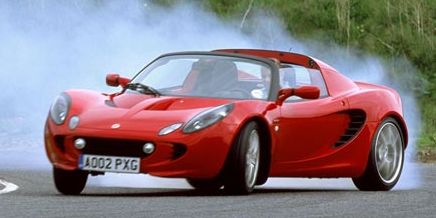
Sixty mph in 4.8 seconds. A quarter-mile time of 13.6 seconds at 102 mph. Braking from 70 mph to a stop in 162 feet. On paper, it looks like this test subject is a mildly interesting performance car with an above-average ability to go and a somewhat ordinary ability to stop.
On pavement? Oh, on pavement the whole script flips. It isn’t until you whirl the wheel of the car to which those numbers are attached that you realize what an incredible machine you’re piloting. It amazes like a Dwyane Wade drive to the hole; nothing should be able to move the way it does. It is, in short, breathtaking.
The car we are referring to, of course, is the Lotus Elise.
A Quick Interlude
If you think the Lotus Elise is cute or bitchin’ and you have perhaps otherwise never heard of it before, you should probably back away slowly. This car is not for the casual user or fainthearted. The ride is harsh by daily-driver standards, there are no cup holders—well, there is one included in the optional Touring Pack, but we’ve never seen it; the Lotus guys tell us it looks like a jock strap. There’s almost no trunk space, and the whole car vibrates and buzzes at cruising speeds. If you want something that’s small, zippy, decent to look at, has a top that goes down, and is actually sort of useful on a day-to-day basis, allow us to point you in the direction of the Mazda MX-5 Miata.
Tenacious Grip and Sublime Steering
Although the Elise’s acceleration and braking numbers might seem slightly pedestrian in sports-car land, here’s one that’s not: 1.00. As in 1.00 g of lateral grip. That’s more than a Porsche Boxster S has and about the same as a Corvette Z06, both of which ride on much wider rubber. And this feat happened on the base Yokohama Advan Neova AD07 tires; stickier tires are an option. We took our Elise to a track day at Grattan Raceway in Belding, Michigan, where this car clawed and gnashed at the pavement—allowing it to keep up with cars packing twice as much horsepower—and refused to give up its hold until absolutely coerced to, usually by a ham-footed driver’s ill-advised midcorner lift. (And, yes, that would be me we’re talking about.)
Only a cliché can describe the turn-in: telepathic. You turn exactly the amount that’s dialed on the wheel—no more, no less—and with only 2.8 turns lock to lock, you usually don’t have to move your hands too far from three and nine. But at the same time, where the unassisted steering is laser-precise on track, at speed, it stays manageable on the road, too—it’s never overly twitchy.
Different Bolt-Ons, but Mostly the Same
The 2007 Elise is pretty much the same car that came to America for the 2005 model year after several years and a whole other generation of European sales. An extruded-aluminum chassis is suspended via control arms front and rear. A Yamaha-sourced, Toyota-branded 1.8-liter four-cylinder engine provides 190 ponies’ worth of power. A copious amount of brake feel is handed out by dual-piston AP Racing calipers in the front and single-piston Brembos out back; 11.5-inch cross-drilled and vented rotors give them something to hold onto.
This content is created and maintained by a third party, and imported onto this page to help users provide their email addresses. You may be able to find more information about this and similar content at piano.io
